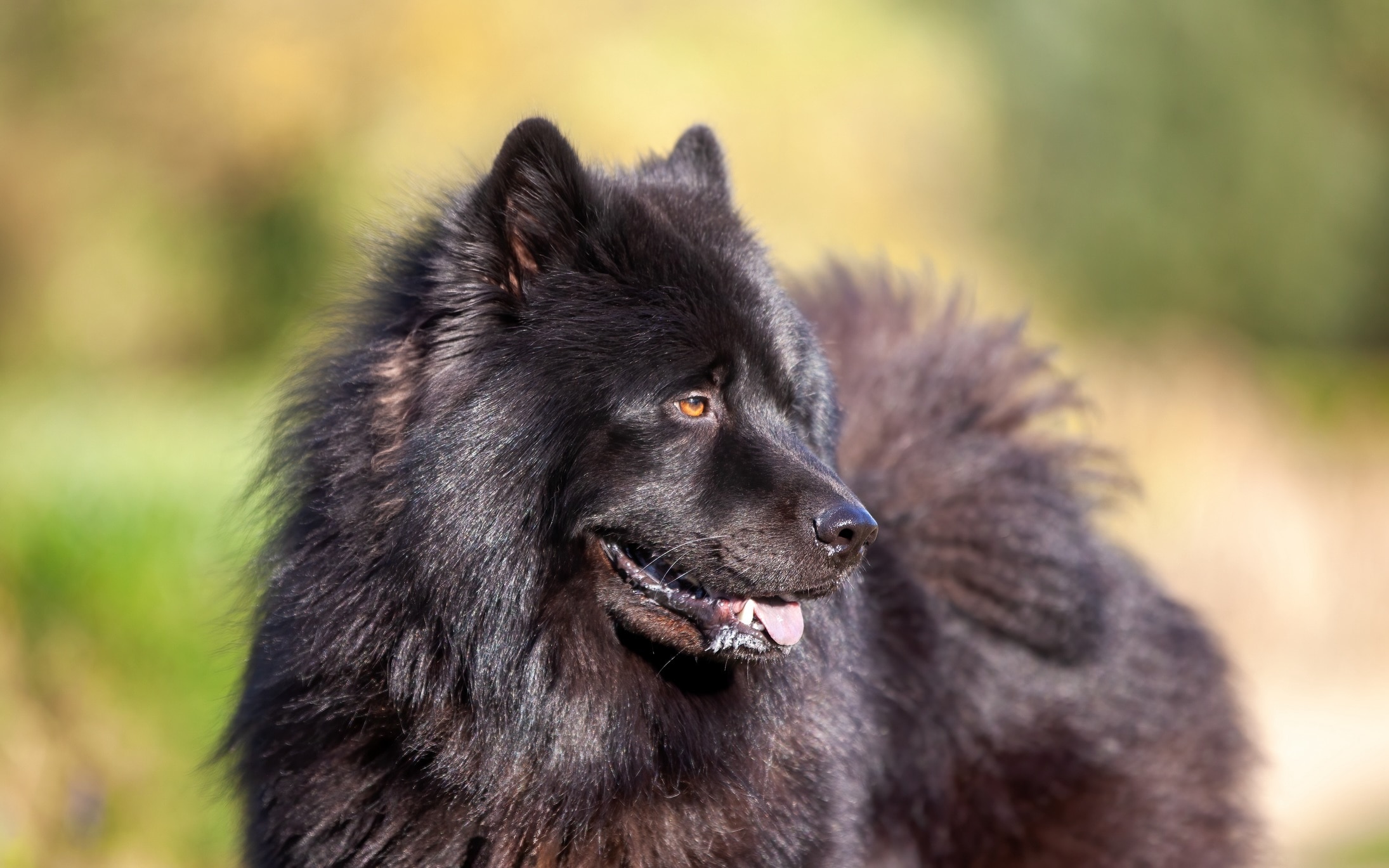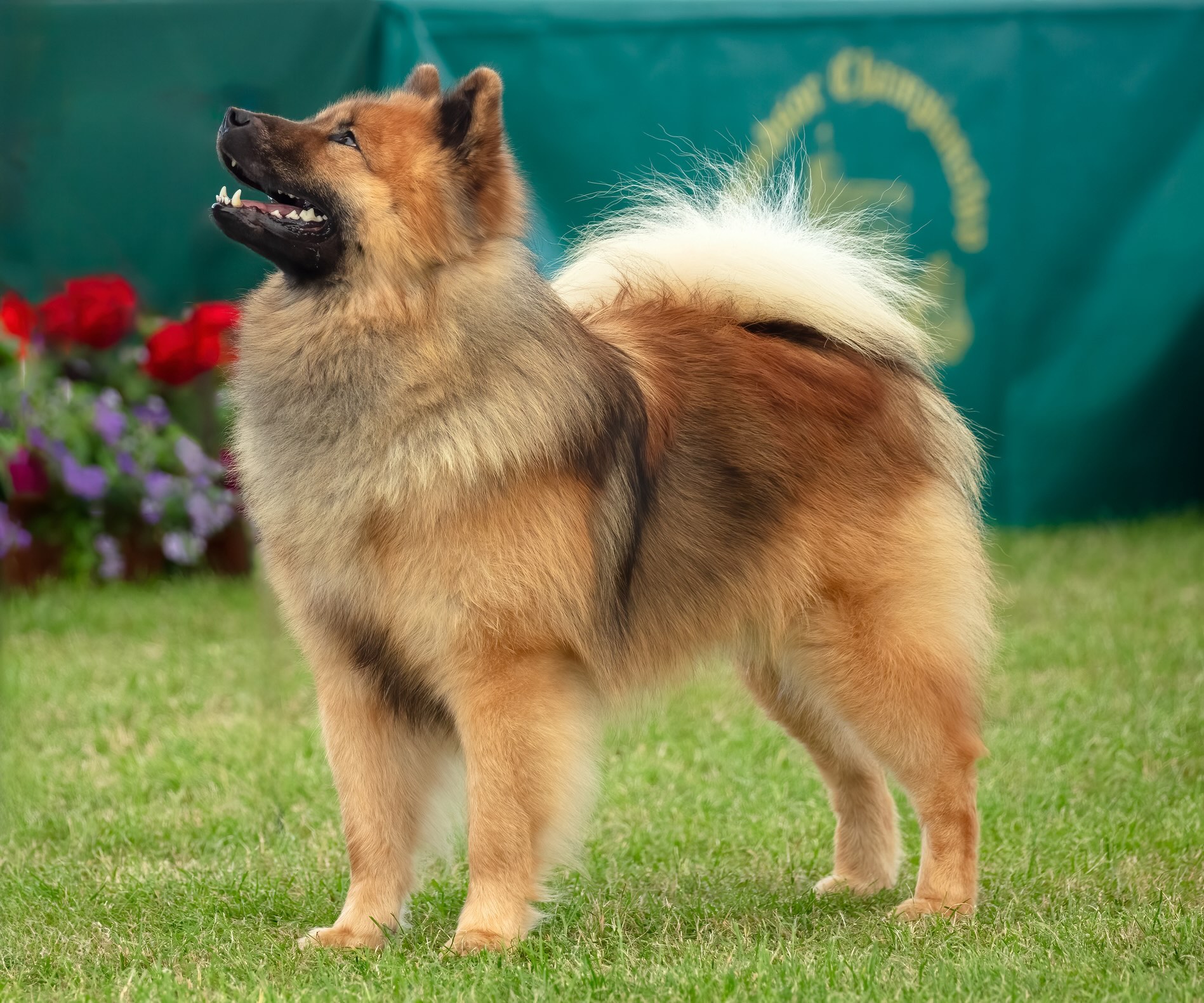Eurasier
cynoclub/iStock / Getty Images Plus via Getty Images
The Eurasier, a modern breed hailing from Germany in the 1960s, is a product of crossbreeding the Chow Chow, the Keeshond (aka the Wolfspitz), and the Samoyed. Originally bred by dog enthusiast Julius Wipfel, the Eurasier was crafted to embody the best qualities of the parent breeds:
-
The Chow Chow’s gentle demeanor
-
The Samoyed’s friendly nature
-
The Keeshond’s intelligence
A medium-sized dog breed typically standing 19–24 inches tall at the shoulder and weighing 40–70 pounds, Eurasiers sport a dense double coat. They require moderate exercise and grooming. This breed's balanced traits and loving disposition make them cherished companions in many households worldwide.
Caring for a Eurasier
The Eurasier is an affectionate breed that can make a great family dog. They are loyal, gentle, calm dogs that form strong bonds with their pet parents, though they may be reserved with strangers.
With a moderate energy level, Eurasiers enjoy daily walks and playtime. This dog breed is intelligent and trainable and responds well to positive reinforcement, though they can be somewhat independent. Known for their empathy, Eurasiers also excel as therapy dogs.
Grooming involves regular brushing to maintain their thick double coat and manage seasonal shedding.
Eurasier Health Issues

Eurasiers are generally healthy dogs with a typical lifespan of 12–16 years. They can be predisposed to a few health issues, so pet insurance might be a good investment for those looking to bring home a Eurasier puppy.
According to the United States Eurasier Club Board of Directors, autoimmune thyroiditis is the most common issue Eurasiers face. But there are other health concerns to be aware of, including:
Autoimmune Thyroiditis
According to the USEC Board of Directors, autoimmune thyroiditis affects 15%–18% of the breed. This condition arises when the immune system attacks the thyroid gland, leading to hypothyroidism. It typically appears in dogs 2–5 years old, though it can occur later.
Regular thyroid testing is essential for Eurasiers, even in seemingly healthy dogs, as early detection and treatment can significantly improve their quality of life.
The USEC Board of Directors notes that treatment is relatively easy, and with daily medication and monitoring, the dogs live long, normal lives.
Diabetes
Diabetes in dogs, similar to humans, is a chronic condition characterized by the body's inability to regulate blood sugar levels properly. There are two types:
-
Type 1, where the pancreas produces little to no insulin
-
Type 2, where the body becomes resistant to insulin
Symptoms include:
-
Weight loss, despite a good appetite
-
Recurrent skin infections and ear infections
Diabetes in Eurasier dogs is typically managed with daily insulin injections, a consistent diet, regular exercise, and frequent monitoring of blood glucose levels.
Exocrine Pancreatic Insufficiency (EPI)
Exocrine pancreatic insufficiency (EPI) is a condition where the pancreas fails to produce enough digestive enzymes, leading to nutrient deficiencies. Your Eurasier may experience chronic diarrhea, weight loss, increased appetite, and poor coat condition.
EPI is managed by supplementing the dog's diet with pancreatic enzymes, feeding a nutrient-rich diet, and sometimes administering vitamin supplements. Regular veterinary checkups are essential to monitor the dog's health and adjust treatment.
Stomach Cancer
Stomach cancer in dogs is relatively rare, but it can occur in breeds including Eurasiers. The most common type is gastric adenocarcinoma. Symptoms include:
-
Loss of appetite
-
Weight loss
-
Abdominal pain
Treatment options for stomach cancer may include surgery to remove the tumor, chemotherapy, and supportive care to manage symptoms and improve quality of life.
Gastric Dilatation-Volvulus (GDV)
Gastric dilatation-volvulus is a life-threatening form of bloat in dogs where the stomach fills with gas and twists. This can cut off blood supply to the stomach and other organs, leading to shock and, if untreated, death.
GDV is a medical emergency that requires immediate veterinary attention. Signs of GDV include:
-
Distended abdomen
-
Retching without producing vomit
-
Pacing
-
Excessive drooling
-
Inability to settle
-
Excessive stretching
Preventive measures include feeding smaller, more frequent meals; avoiding vigorous exercise around mealtimes; and using slow-feeder bowls to slow your dog down as they eat.
Joint Problems
Eurasiers can develop several joint conditions throughout their life, including:
-
Hip dysplasia, where abnormal growth causes the hip joint to become loose and eventually leads to arthritis.
-
Elbow dysplasia, a condition similar to hip dysplasia but affecting the elbow joints.
-
Patellar luxation, where the kneecap moves out of place.
Talk to your veterinarian if you notice changes in your dog’s gait, such as if they have a limp that comes and goes, if they’re holding a leg up as they walk, or if they seem to have a hard time going up and down stairs or getting on and off furniture.
What To Feed a Eurasier

Eurasiers are largely considered a healthy breed and have no specific concerns for their diet, according to the USEC Board of Directors. They aren’t known for having environmental or food allergies (though, it’s not impossible for a Eurasier to develop an allergy), so any high-quality, protein-first diet is a good choice for your dog.
Make sure the food you give your dog meets the guidelines set by the Association of American Feed Control Officials (AAFCO).
How To Feed a Eurasier
Eurasiers benefit from a consistent feeding routine tailored to their life stage.
-
Eurasier puppies up to 6 months old should have three or four meals a day to support their rapid growth, while adolescents between 6 months and 1 year old can transition to two to three meals daily. They should eat a dog food made for puppies.
-
Adult Eurasiers thrive on two meals a day of an adult-formulated dog food, which helps maintain steady energy levels and prevents overeating.
-
Senior Eurasiers may require lower-calorie, senior-specific formulas, and smaller, more frequent meals to accommodate changes in their metabolism.
Using slow-feeder bowls can moderate your dog’s eating speed and reduce digestive issues.
How Much Should You Feed a Eurasier?
Feeding amounts for Eurasiers vary based on age, size, activity level, and metabolism. To ensure your Eurasier's nutritional needs are met, follow the guidelines on your dog food packaging and work with your veterinarian to adjust as needed.
Always measure out your Eurasier’s meals to prevent obesity. Monitor your dog’s body condition, and schedule a vet appointment if you have concerns.
Nutritional Tips for Eurasiers
Though healthy Eurasiers will get all needed nutrients from their AAFCO-compliant dog food, supplements can help if your dog is diagnosed with or at risk for certain conditions.
-
Omega-3 fatty acids (fish oil) help promote healthy skin, a shiny coat, and joint health.
-
Joint supplements containing glucosamine and chondroitin help maintain joint function and reduce inflammation, especially as your dog ages.
-
Probiotics support digestive health.
-
Multivitamins ensure your Eurasier receives essential vitamins and minerals, filling dietary gaps.
Before giving your Eurasier any supplements, consult your veterinarian to ensure they meet your Eurasier's specific needs.
Behavior and Training Tips for Eurasiers
Eurasier Personality and Temperament

A Eurasier’s exercise needs are fairly straightforward: A healthy walk or hike for about an hour a day, with opportunities to sniff and explore, is usually sufficient. After a busy day, they’re happy to relax with their family.
According to the USEC Board of Directors, the Eurasier dog breed was bred first and foremost to be a companion, so they can excel as family pets. They do well with other pets and children when well-socialized and properly introduced. But, as with any dog, new pet parents need to teach children to be respectful and kind to pets.
Eurasier Behavior
Eurasiers are cheerful, confident, relaxed dogs that maintain a close bond with their family despite being reserved with strangers. They are described as humorous and engaging pets that make for entertaining household members.
While they are generally quiet, they will occasionally bark when a neighbor walks by or a delivery person approaches your home. Adaptable and socially savvy, Eurasiers are easygoing companion dogs that thrive on joining their pet parents in daily adventures.
Whether it’s traveling, running errands, or neighborhood walks, Eurasiers are up for anything!
Eurasier Training
Eurasiers thrive on positive reinforcement and interactive, engaging training sessions. Their intelligence and close bond with humans make them eager learners in obedience and dog sports. They excel with varied and engaging activities but dislike repetitive drills.
To keep your pup motivated, incorporate diverse training tasks and respect their independent nature. Positive reinforcement and mental stimulation are key to successful training with this breed.
Fun Activities for Eurasiers
-
Hiking
-
Frisbee
-
Playing with interactive toys
-
Nose work
Eurasier Grooming Guide
Eurasiers have a distinct double coat, with a straight guard-hair layer covering a soft undercoat. This coat sheds heavily in the spring and fall.
Although the coat is not predisposed to matting, frequent grooming—especially during shedding periods—is important to prevent tangling or matting. Despite this, their coat is generally easy to maintain with regular brushing and an occasional bath.
Skin Care
Eurasiers generally have minimal special skin-care needs. Although frequent baths are not necessary, an occasional wash with a gentle dog shampoo helps keep their skin and coat healthy without stripping natural oils.
Coat Care
Eurasiers need to be brushed two to three times per week to manage shedding. Professional grooming isn’t necessary, but occasional visits can help give your dog a thorough cleaning.
The double coat isn’t generally prone to matting, though more frequent brushing during heavy shedding can prevent tangling.
Eye Care
Eurasiers generally do not require special eye care beyond routine veterinary checkups. Talk to your vet if you notice changes in your dog’s eyes, such as redness or discharge.
It can be helpful to trim the fur around their eyes if it grows long enough to disrupt their vision.
Ear Care
Regularly inspect your dog’s ears for signs of an ear infection: redness, discharge, or odor. Clean their ears with a dog-specific ear cleaner if there is excess wax or debris, but routine cleaning is usually unnecessary unless a vet recommends it.
Talk to your vet if your dog develops recurring ear infections, as this can be a sign of autoimmune thyroiditis.
Considerations for Pet Parents

Before bringing a Eurasier puppy home, pet parents should be aware of several key factors to ensure this breed is a good fit for their lifestyle.
The perfect home for a Eurasier is one where they receive plenty of attention, get lots of time outside with their humans, and are integrated into family life. They thrive in environments where they can participate in daily adventures, such as walks and hikes, and engage in interactive training.
Eurasiers require two or three brushing sessions per week to manage their double coat. An ideal home will provide consistent grooming, mental stimulation, and regular exercise.
Eurasier FAQs
Are Eurasiers cuddly?
Yes, Eurasiers are known to be quite cuddly with their family. But it’s important to remember every dog is an individual, and some Eurasiers might be more affectionate than others.
Is the Eurasier a good family dog?
Yes, the Eurasier can be a great family dog. Known for their friendly and loving nature, Eurasiers typically get along well with other pets and children, making them a good choice for families.
Are Eurasier dogs rare?
Yes, Eurasiers are a relatively rare dog breed in the U.S. Originally developed in Germany in 1960, Eurasiers are more commonly found in Europe.
References
The Board of Directors of The United States Eurasier Club (USEC), met during their monthly board meeting to focus on their interview for this article. The contributors were: Tanya Brady (President); Wendy Schuyler (Vice President, International Relations/IFEZ), Kelsey Keefe (Communications Coordinator, AKC Liaison), Maureen Schwarz (Breeding Coordinator), Snowy Chen (Treasurer and Club Secretary).
